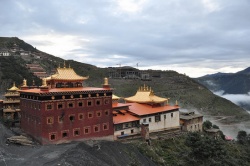Difference between revisions of "How to Build a Monastery"
(Created page with "<poem> At Katok, there were no less than three major construction projects going on simultaneously. Each of these buildings required large numbers of dump trucks, concrete mi...") |
|||
| (2 intermediate revisions by the same user not shown) | |||
| Line 1: | Line 1: | ||
| + | [[File:30b6e z.jpg|thumb|250px|]] | ||
| + | |||
| + | |||
| + | |||
| + | |||
| + | |||
| + | |||
| + | |||
<poem> | <poem> | ||
| − | At Katok, there were no less than three major construction projects going on simultaneously. Each of these buildings required large numbers of dump trucks, concrete mixers and workers. While I’m sure that the results will be impressive, the current situation can only be described as chaotic and dirty. In his Footprint Tibet guidebook, Gyurme Dorje extols the serenity of Katok monastery, saying, “Anyone viewing the majestic setting of Katok’s red and white buildings which cover the peaceful mountain top can appreciate why the concept of | + | At [[Katok]], there were no less than three major construction projects going on simultaneously. Each of these buildings required large numbers of dump trucks, concrete mixers and workers. While I’m sure that the results will be impressive, the current situation can only be described as chaotic and dirty. In his Footprint [[Tibet]] guidebook, [[Gyurme Dorje]] extols the [[serenity]] of [[Katok monastery]], saying, “Anyone viewing the majestic setting of [[Katok’s]] [[red]] and white buildings which cover the [[peaceful]] mountain top can appreciate why the {{Wiki|concept}} of ‘[[sacred]] outlook’ or ‘[[pure]] [[visionary]] [[perception]] of the landscape’ is so significant here.” |
| − | + | [[File:Dampa Deshek77.jpeg|thumb|250px|]] | |
| − | While this may have been true in the past, Katok monastery’s peaceful mountaintop is currently dominated by construction noise. An entire hillside has been turned black by detritus poured out by a continuous stream of dump-trucks | + | While this may have been true in the {{Wiki|past}}, [[Katok monastery’s]] [[peaceful]] mountaintop is currently dominated by construction noise. An entire hillside has been turned black by detritus poured out by a continuous {{Wiki|stream}} of dump-trucks . Arriving here after the [[peace]] of [[Palpung]], the [[activity]], dirt and noise was quite a [[shock]]. Furthermore, I was not the only one who objected to all the [[activity]]: several of the [[monks]] I spoke with also expressed distaste at what was going on, even questioning the need for the new buildings at all. Looking at the black debris on the hillside, one [[monk]] commented, “[[Nothing]] will grow there again.” Like many [[monasteries]], [[Katok]] does not have a clear hierarchical {{Wiki|structure}} with a single head. Instead, different [[lamas]] are each responsible for their [[own]] [[sections]] of the [[monastery]]. In the case of [[Katok]], this seems to have lead to competing construction projects, with little regard for the overall impact on the [[monastery]] or its {{Wiki|environment}}. To be fair, timber construction has its [[own]] {{Wiki|environmental}} problems. All those [[trees]] have to come from somewhere, and even in pre-modern times, deforestation was a {{Wiki|real}} issue in [[Kham]]. Still, the difference between the construction and its {{Wiki|attendant}} {{Wiki|environmental}} issues at [[Palpung]] and [[Katok]] is striking, and I can’t help but [[feel]] like there must be a better way to do this. |
| − | Katok is not alone in choosing concrete over more traditional construction methods. Almost every monastery I visited had some form of construction work going on, and most were employing concrete construction methods (Karndzé Nunnery is another notable exception. The new Chenrezik temple there was being built entirely with traditional stonework). Of course, as a tourist, it is easy to praise the beauty of traditional construction and denigrate modern techniques. The monks who live in these monasteries, however, may appreciate the conveniences provided by modern construction (such as, say, basic plumbing). Nevertheless, it seems like something has been lost when an already significant monastery, like Katok, dedicates so much capital to a project, only to damage its own environment in the process. | + | [[Katok]] is not alone in choosing concrete over more [[traditional]] construction [[methods]]. Almost every [[monastery]] I visited had some [[form]] of construction work going on, and most were employing concrete construction [[methods]] ([[Karndzé Nunnery]] is another notable exception. The new [[Chenrezik]] [[temple]] there was being built entirely with [[traditional]] stonework). Of course, as a tourist, it is easy to praise the [[beauty]] of [[traditional]] construction and denigrate {{Wiki|modern}} [[techniques]]. The [[monks]] who [[live]] in these [[monasteries]], however, may appreciate the conveniences provided by {{Wiki|modern}} construction (such as, say, basic plumbing). Nevertheless, it seems like something has been lost when an already significant [[monastery]], like [[Katok]], dedicates so much {{Wiki|capital}} to a project, only to damage its [[own]] {{Wiki|environment}} in the process. |
</poem> | </poem> | ||
{{R}} | {{R}} | ||
[http://thelostyak.com/2010/09/06/how-to-build-a-monastery/ thelostyak.com] | [http://thelostyak.com/2010/09/06/how-to-build-a-monastery/ thelostyak.com] | ||
[[Category:Katok Monastery]] | [[Category:Katok Monastery]] | ||
Latest revision as of 16:30, 1 April 2024
At Katok, there were no less than three major construction projects going on simultaneously. Each of these buildings required large numbers of dump trucks, concrete mixers and workers. While I’m sure that the results will be impressive, the current situation can only be described as chaotic and dirty. In his Footprint Tibet guidebook, Gyurme Dorje extols the serenity of Katok monastery, saying, “Anyone viewing the majestic setting of Katok’s red and white buildings which cover the peaceful mountain top can appreciate why the concept of ‘sacred outlook’ or ‘pure visionary perception of the landscape’ is so significant here.”
While this may have been true in the past, Katok monastery’s peaceful mountaintop is currently dominated by construction noise. An entire hillside has been turned black by detritus poured out by a continuous stream of dump-trucks . Arriving here after the peace of Palpung, the activity, dirt and noise was quite a shock. Furthermore, I was not the only one who objected to all the activity: several of the monks I spoke with also expressed distaste at what was going on, even questioning the need for the new buildings at all. Looking at the black debris on the hillside, one monk commented, “Nothing will grow there again.” Like many monasteries, Katok does not have a clear hierarchical structure with a single head. Instead, different lamas are each responsible for their own sections of the monastery. In the case of Katok, this seems to have lead to competing construction projects, with little regard for the overall impact on the monastery or its environment. To be fair, timber construction has its own environmental problems. All those trees have to come from somewhere, and even in pre-modern times, deforestation was a real issue in Kham. Still, the difference between the construction and its attendant environmental issues at Palpung and Katok is striking, and I can’t help but feel like there must be a better way to do this.
Katok is not alone in choosing concrete over more traditional construction methods. Almost every monastery I visited had some form of construction work going on, and most were employing concrete construction methods (Karndzé Nunnery is another notable exception. The new Chenrezik temple there was being built entirely with traditional stonework). Of course, as a tourist, it is easy to praise the beauty of traditional construction and denigrate modern techniques. The monks who live in these monasteries, however, may appreciate the conveniences provided by modern construction (such as, say, basic plumbing). Nevertheless, it seems like something has been lost when an already significant monastery, like Katok, dedicates so much capital to a project, only to damage its own environment in the process.

